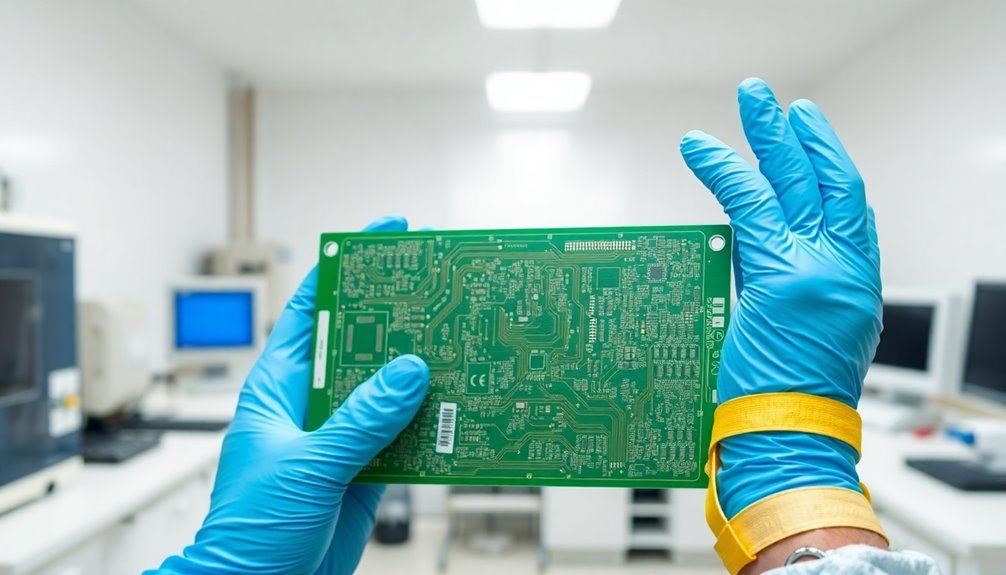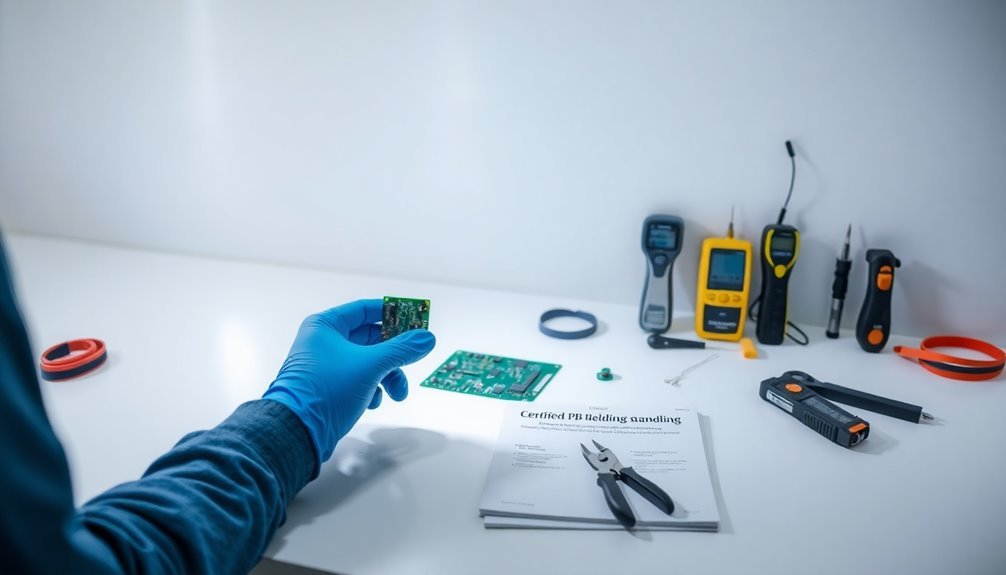To get PCB handling certification today, you'll need to complete specific training requirements and pass certification exams like IPC-A-600 CIS or IPC-6012 CIS with Space Addendum. Start by enrolling in the IPC EDGE Learning Management System, where you can access self-paced online modules and interactive quizzes. You'll need to score at least 80% on the final exam, with three attempts allowed. The certification process also requires thorough documentation of your training and experience. Once certified, you'll maintain your credentials by earning 100 Professional Development Units every two years. The steps below will guide you through each certification requirement.
Understanding PCB Certification Types

In today's electronics manufacturing landscape, PCB certification types serve as essential quality benchmarks that determine a board's suitability for specific applications. If you're seeking PCB handling certification, you'll need to understand the key standards that govern different industries.
For general manufacturing, ISO 9001 provides the foundation for quality management systems. Achieving this certification requires documented procedures for all manufacturing processes. If you're working with medical devices, you'll need ISO 13485, which adds specific requirements for regulatory compliance and risk management.
For aerospace projects, AS9100 certification is mandatory, building on ISO 9001 with industry-specific regulations.
You'll also encounter IPC classifications that define quality levels. Class 1 suits consumer electronics where cost is key, Class 2 meets industrial and medical requirements, and Class 3 serves aerospace and military applications demanding the highest reliability.
Additionally, you'll need to understand UL certifications for safety compliance and IPC standards like IPC-A-600 for bare board inspections.
Each certification type requires specific training, documentation, and adherence to strict protocols. You'll need to identify which certifications align with your industry's requirements and guarantee your processes meet these standards through regular audits and updates.
Required Documents and Prerequisites
To earn your PCB Handling Certification, you'll need to submit thorough educational records including official transcripts and training certificates that verify your completed coursework.
Your application must include detailed work experience documentation, featuring signed job descriptions and employment verification letters on company letterhead.
The certification process also requires you to complete specific forms and provide ethics-related documentation, including any disciplinary actions or felony convictions that must be disclosed with explanatory letters. Additionally, you must complete 75 hours of training from authorized peer specialist training vendors.
Essential Educational Paperwork
Several essential documents must be prepared when pursuing PCB handling certification. You'll need to have your official college transcripts sent directly from your institution to the PCB Office. If you don't have college education, a copy of your high school diploma or GED is acceptable.
For your educational requirements, remember that three college credits equal 45 hours, and all education must relate to the certification domains. You can include CPR/First Aid and computer learning for up to six hours each. A thorough design evaluation process will be required during your certification journey. If you've provided education to others, you can count that too with written verification.
| Document Type | Requirements |
|---|---|
| Transcripts | Must be sent directly from institution |
| Training Certificates | Copies of attendance required |
| Employment History | Previous employer letters verifying duties |
| Job Description | Current position details signed by you and supervisor |
| Education Hours | Three credits = 45 hours |
| Certification Types | IPC, UL, ISO standards documentation |
Don't forget to include copies of any relevant training certificates and your current job description signed by both you and your supervisor. Your application will remain active for one year after review.
Work Experience Documentation
Proper documentation of your work experience forms a crucial part of PCB handling certification. You'll need to submit detailed documentation for both your current and previous employment as a prevention specialist.
For your current position, you must provide a job description signed by both you and your immediate supervisor. This document needs to detail your duties, responsibilities, weekly hours, and time in the position. The rapidly growing PCB industry value of $71.57 billion demonstrates the increasing importance of proper certification in this field.
If you've held multiple prevention roles within your organization, include all relevant job descriptions.
Previous employment requires verification letters on company letterhead from each employer. These letters must specify your job title, duties, employment dates, weekly hours, and the employer's contact information including city and zip code.
You'll also need to document 120 hours of on-the-job supervision, with at least 10 hours in each prevention domain. This supervision can come from multiple supervisors and take place in individual or group settings.
Forms and Ethics Records
Building on your work experience documentation, a complete set of forms and ethics records serves as the foundation for PCB handling certification.
You'll need to submit a detailed certification application along with detailed documentation of PCB design, testing, and compliance records. Each PCB order must include a Certificate of Conformance that specifies treatment type, material specifications, and test results.
You must maintain thorough prototype testing records and inspection documentation from certification bodies. Your current employer needs to provide a signed and dated job description verifying your duties and employment dates.
You'll also need to submit annual conflict of interest disclosures and demonstrate compliance with the industry's code of ethics.
To meet regulatory requirements, verify all your materials and processes align with approved standards. All handling and testing procedures must be conducted at static-controlled workstations to prevent ESD damage. You'll need to document your formal education, such as IPC-A-600 CIS certification, and pass required certification exams like IPC-6012 CIS with Space Addendum.
If you're an inspector, you must meet visual acuity standards according to NASA-STD-8739.6 or IPC-QL-653. Remember that certification authorities must recognize and approve all documentation you submit.
Education and Training Standards

Industry-standard PCB handling certification requires thorough education and training across multiple quality management systems. You'll need to master ISO 9001 fundamentals, including documented manufacturing procedures, quality control protocols, and continuous improvement processes. Clear formatting helps break down these complex certification requirements into manageable segments.
Additionally, you must understand how to conduct regular audits and implement corrective actions for non-conformities.
If you're working with medical devices, ISO 13485 certification demands specific training in risk management, design controls, and FDA 21 CFR 820 compliance. You'll also need to demonstrate proficiency in purchasing controls and regulatory audit procedures for medical device components.
For aerospace applications, you must complete AS9100 training, which covers gap analysis, QMS implementation, and FAA compliance requirements. You'll need to show competency in aerospace-specific quality management procedures and continuous improvement methods.
Core PCB handling training requires certification in IPC-A-600 and IPC-J-STD-001 standards. You must gain expertise in UL certification requirements, PCB inspection protocols, and testing procedures.
Understanding PCB design, manufacturing processes, and industry-specific certifications for different classes (1, 2, and 3) is essential for successful certification completion.
Application Steps and Process
Traversing the PCB handling certification process requires careful preparation and systematic documentation. You'll need to start by ensuring your PCB materials meet regulatory requirements and compiling thorough documentation of your design and testing procedures.
| Phase | Duration | Key Requirements |
|---|---|---|
| Preparation | 2-3 weeks | Material compliance, documentation, prototype testing |
| Application | 5-10 days | Completed forms, payment, required certificates |
| Certification | 5-10 days | Successful inspection, standards compliance |
Begin by submitting your application according to the certification body's guidelines, including all required documentation and payment. You'll receive confirmation of your submission, and the review process typically takes 5-10 business days. During this time, certification staff will evaluate your application's completeness and accuracy. To maintain clarity throughout the application process, your submitted documents should be organized in a numbered list format.
If approved, you'll move forward to the inspection and testing phase, where your PCB will be evaluated for compliance with specified standards. Upon successful completion, you'll receive your certification, valid for two years. Keep in mind that if your application is denied, you can pursue an appeal process. Remember to maintain detailed records throughout each step, as they'll be essential for both initial certification and future renewals.
Exam Preparation and Testing

Successful PCB handling certification requires thorough preparation for the exhaustive examination process. You'll need to master key modules covering PCB fabrication and assembly through the IPC EDGE Learning Management System, where you can study at your own pace. The online self-paced format allows complete flexibility in your learning schedule.
The course content focuses on critical areas including via formation, metallization, electroplating technologies, and circuit board assembly processes. You'll learn about pattern plating, imaging issues, and proper preplate setup, along with surface mount and through-hole assembly workflows.
To strengthen your understanding, you'll complete interactive module quizzes before attempting the final exam.
When you're ready for certification, you'll need to score at least 80% on the final exam. Don't worry if you don't pass on your first try – you get three attempts, with a 24-hour waiting period required after the second attempt.
The exam tests your knowledge of PCB fabrication, assembly, and solderable finish selection. This certification is particularly valuable if you're an engineer, technician, operator, or staff member involved in PCB manufacturing.
You'll also gain essential knowledge about industry standards, including IPC-4101, UL 94V-0, and RoHS compliance requirements.
Certification Maintenance Requirements
After earning your PCB handling certification, you'll need to maintain it through ongoing professional development. The certification renewal cycle occurs every two years, during which you must earn 100 Professional Development Units (PDUs). At least 50 of these PDUs should directly relate to security practices in PCB handling.
You can earn your PDUs through various activities:
- Attending training courses and workshops focused on PCB handling techniques and safety protocols
- Participating in industry conferences where you'll learn about new developments in PCB technology
- Gaining professional experience through documented work achievements and projects
Keep detailed records of all your PDU activities, as you're responsible for maintaining proper documentation.
You can submit your recertification application up to three months before your expiration date through your online account or by mail. If you miss the deadline, you'll need to pay an additional reinstatement fee, and remember that recertification isn't possible if your credentials have lapsed for more than 12 months.
All educational activities must have been completed within two years of your current expiration date to count toward your PDU requirements.
Frequently Asked Questions
How Much Does PCB Certification Typically Cost?
You'll typically spend $200-$1,000 for PCB handling certification, depending on the type and provider. Basic awareness courses cost less, while specialized certifications like IPC J-STD-001 are on the higher end.
Can I Transfer My PCB Certification Between Different States?
Yes, you can transfer your certification between states if both jurisdictions are IC&RC member boards. You'll need to complete a reciprocity application through your current board and meet any additional state-specific requirements.
What Percentage of Applicants Pass the Certification Exam on First Attempt?
You'll find pass rates vary widely among PCB certification programs, though specific first-attempt rates aren't publicly reported. Based on similar technical certifications, you can expect roughly 40-50% success on your first try.
Are There Age Restrictions for Obtaining PCB Handling Certification?
You won't find specific age restrictions for PCB handling certification. The requirements focus on your professional experience, training completion, and ability to meet safety standards rather than your age.
Can I Work While Completing My PCB Certification Requirements?
Yes, you can continue working while pursuing PCB certification. Most programs offer flexible scheduling and online courses. You'll need to balance your work commitments with certification requirements like training sessions and exams.
In Summary
Now that you've learned about PCB handling certification, you'll need to take action. Start by selecting your certification type, gathering documents, and enrolling in an accredited training program. Don't forget to study thoroughly for your exam and maintain detailed records of your work experience. Once certified, keep track of renewal requirements and continuing education to verify your credentials remain current in this evolving industry.





Leave a Reply